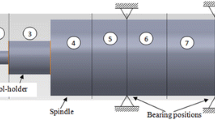Abstract
The kinematics of helical milling on a three-axis machine tool is first analysed. An analytical model dealing with time domain cutting forces is proposed in this paper. The cutting force model is established in order to accurately predict the cutting forces and torque during helical milling operations as a function of helical feed, spindle velocity, axial and radial cutting depth and milling tool geometry. The forces both on the side cutting edges and on the end cutting edges along the helical feed path are described by considering the tangential and the axial motion of the tool. The dual periodicity which is caused by the spindle rotation, as well as the period of the helical feed of the cutting tool, has been included. Both simulation and experiments have been performed in order to compare the results obtained from modelling with experiments.
Similar content being viewed by others
References
Iyer R, Koshy P, Ng E (2007) Helical milling: an enabling technology for hard machining precision holes in AISI D2 tool steel. Int J Mach Tool Manuf 47(2):205–210
Denkena B, Boehnke D, Dege JH (2008) Helical milling of CFRP—titanium layer compounds. CIRP J Manuf Sci Tech 1(2):64–69
Sasahara H, Kawasaki M, Tsutsumi M (2003) Helical feed milling with MQL for boring of aluminum alloy. Trans Jpn Soc Mech Eng C 69(8):2156–2161. doi:10.1299/kikaic.69.2156
Altintas Y (2000) Manufacturing automation: principles of metal cutting and machine tool vibrations. New York, Cambridge
Altintas Y, Engin S (2001) Generalized modeling of mechanics and dynamics of milling cutters. CIRP Ann Manuf Technol 50(1):25–30
Liu XW, Cheng K, Webb D, Luo XC (2002) Improved dynamic cutting force model in peripheral milling. Part I: theoretical model and simulation. Int J Adv Manuf Technol 20(9):631–638
Liu XW, Cheng K, Webb D, Longstaff AP, Widiyarto MH (2004) Improved dynamic cutting force model in peripheral milling. Part II: experimental verification and prediction. Int J Adv Manuf Technol 24(11–12):794–805
Li HZ, Zhang WB, Li XP (2001) Modelling of cutting forces in helical end milling using a predictive machining theory. Int J Mech Sci 43(8):1711–1730
Lai W, Greenway B, Faddis T (2001) Flute engagement in peripheral milling. J Mater Process Technol 117(1–2):1–8
Fussell BK, Jerard RB, Hemmett JG (2003) Modeling of cutting geometry and forces for 5-axis sculptured surface machining. CAD Comput Aided Des 35(4):333–346
Larue A, Altintas Y (2005) Simulation of flank milling processes. Int J Mach Tool Manuf 45(4–5):549–559
Wei ZC, Wang MJ, Han XG (2010) Cutting forces prediction in generalized pocket machining. Int J Mach Tool Manuf 50(5–8):449–458
Lazoglu I, Liang SY (2000) Modeling of ball-end milling forces with cutter axis inclination. J Manuf Sci Eng Trans ASME 122(1):3–11
Budak E, Ozturk E, Tunc LT (2009) Modeling and simulation of 5-axis milling processes. CIRP Ann Manuf Technol 58(1):347–350
Ozturk E, Budak E (2010) Dynamics and stability of five-axis ball-end milling. J Manuf Sci Eng Trans ASME 132(2). doi:10.1115/1.4001038
Gradisek J, Kalveram M, Weinert K (2004) Mechanistic identification of specific force coefficients for a general end mill. Int J Mach Tool Manuf 44(4):401–414
Ko JH, Altintas Y (2007) Dynamics and stability of plunge milling operations. J Manuf Sci Eng Trans ASME 129(1):32–40
Altintas Y, Ko JH (2006) Chatter stability of plunge milling. CIRP Ann Manuf Technol 55(1):361–364
Ko JH, Altintas Y (2007) Time domain model of plunge milling operation. Int J Mach Tool Manuf 47(9):1351–1361
Damir A, Ng EG, Elbestawi M (2011) Force prediction and stability analysis of plunge milling of systems with rigid and flexible workpiece. Int J Adv Manuf Technol 54(9–12):853–877
Pirtini M, Lazoglu I (2005) Forces and hole quality in drilling. Int J Mach Tool Manuf 45(11):1271–1281
de Lacalle LNL, Rivero A, Lamikiz A (2009) Mechanistic model for drills with double point-angle edges. Int J Adv Manuf Technol 40(5–6):447–457
Shatla M, Altan T (2000) Analytical modeling of drilling and ball end milling. J Mater Process Technol 98(1):125–133
Elhachimi M, Torbaty S, Joyot P (1999) Mechanical modelling of high speed drilling. 1: Predicting torque and thrust. Int J Mach Tool Manuf 39(4):553–568
Elhachimi M, Torbaty S, Joyot P (1999) Mechanical modelling of high speed drilling. 2: Predicted and experimental results. Int J Mach Tool Manuf 39(4):569–581
Hamade RF, Seif CY, Ismail F (2006) Extracting cutting force coefficients from drilling experiments. Int J Mach Tool Manuf 46(3–4):387–396
Li Z, Liu Q, Peng C, Sun X (2010) Cutting force modeling and simulation for hole-making operation by helical milling. Proc SPIE 7997:799703. doi:10.1117/12.883034
Wang H, Qin X, Ren C, Wang Q (2011) Prediction of cutting forces in helical milling process. Int J Adv Manuf Technol. doi:10.1007/s00170-011-3435-y
Author information
Authors and Affiliations
Corresponding author
Rights and permissions
About this article
Cite this article
Liu, C., Wang, G. & Dargusch, M.S. Modelling, simulation and experimental investigation of cutting forces during helical milling operations. Int J Adv Manuf Technol 63, 839–850 (2012). https://doi.org/10.1007/s00170-012-3951-4
Received:
Accepted:
Published:
Issue Date:
DOI: https://doi.org/10.1007/s00170-012-3951-4



